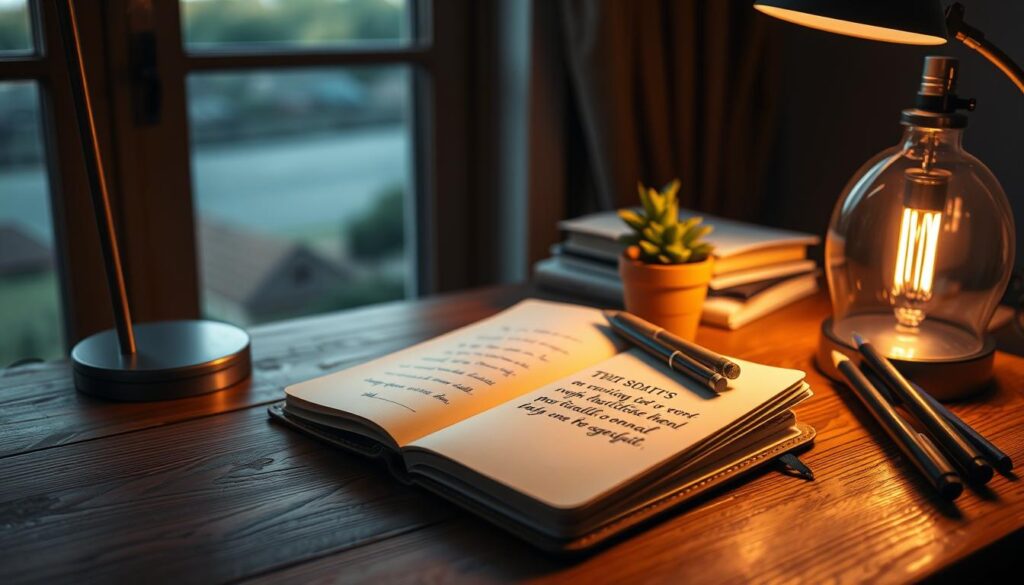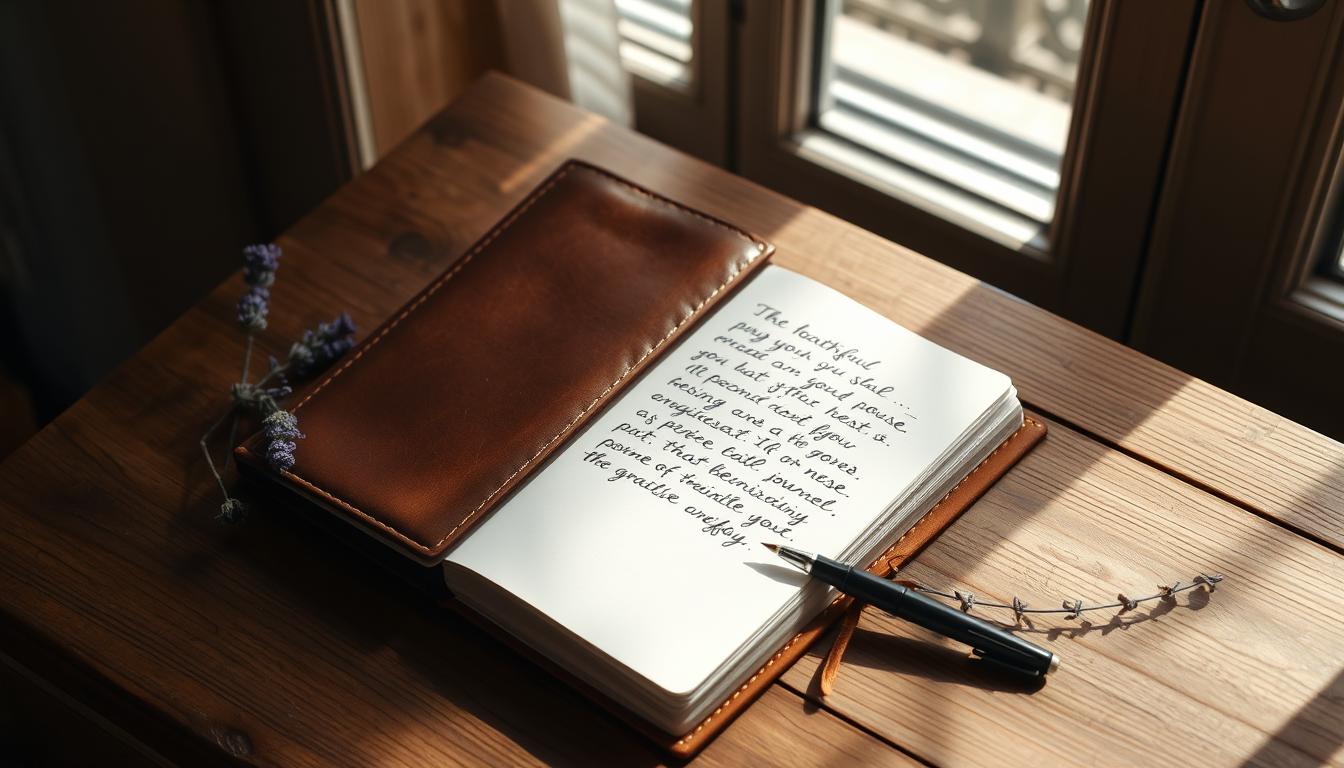Three years ago, I found a practice that changed my life: gratitude journaling. It was a time filled with stress and negativity. But this simple habit became my emotional lifeline.
Gratitude journaling isn’t about pretending to be happy. It’s about noticing the small joys we often miss. By spending just five minutes each day, I’ve learned to focus on the positive.
The beauty of gratitude journaling is how simple it is. You don’t need fancy tools or complicated plans. All you need is a blank notebook, a quiet spot, and a willingness to reflect.
Table of Contents
Key Takeaways
- Gratitude journaling can dramatically shift your mental perspective
- No special equipment is needed to start your practice
- Just five minutes daily can create significant emotional changes
- Recognize and appreciate small, meaningful moments
- Develop consistent positivity habits through reflection
Understanding the Power of Daily Gratitude Practice
Discovering gratitude’s power changed my life. Mental clarity is real, thanks to daily gratitude. It changes how we live.

Science shows how gratitude affects our brain and mood. Positivity is learned, not given. It comes from practicing every day.
The Neuroscience of Gratitude
Studies show gratitude changes our brain. Our brain’s paths can change with positive thoughts. Here’s what happens:
- Increased dopamine and serotonin production
- Reduced stress hormone levels
- Enhanced emotional regulation
Mental Health Benefits
Gratitude is more than a good feeling. It’s a strong tool for mental health. By focusing on the good, we:
- Notice positive moments more
- Stay strong when things get tough
- Feel better overall
Gratitude turns what we have into enough, and more.
Adding gratitude to our daily life does more than just journaling. It reshapes our mind to focus on the positive and clear thoughts.
Starting Your Gratitude Journey Today

Starting a gratitude journal can seem daunting at first. I felt the same way when I began. But, the truth is, it’s easier than you might think.
For More Information Click Here
Here are some simple steps to start your gratitude journaling:
- Choose a journal that speaks to you – it could be a simple notebook or a dedicated gratitude journal
- Set aside 5-10 minutes daily for reflection
- Find a consistent time that works with your schedule
- Start with just three things you’re grateful for each day
I started with small goals in my gratitude journaling. I wrote about simple things I appreciated, like a warm cup of coffee or a kind smile from a stranger.
Remember, gratitude journaling is a personal journey. There’s no perfect way to do it.
The most important thing is to be consistent and true to yourself. Don’t worry about writing perfectly or having deep insights every day. It’s about noticing and appreciating the good things in life.
As you keep up with gratitude journaling, you’ll start to see things differently. It gets easier and more rewarding over time.
Essential Elements of a Gratitude Journal
Starting a gratitude journal is about understanding its core parts. It’s not just a notebook. It’s a tool for growing and feeling better.

Choosing the right journal is key. I’ve found different types work for different people:
- Digital apps for tech-savvy individuals
- Traditional paper notebooks for tactile learners
- Specialized gratitude journals with pre-designed prompts
- Simple blank journals for free-form writing
Crafting Your Writing Routine
Creating a writing routine is important. Start small, with 5-10 minutes a day. Find a time that fits your schedule, like morning or before bed.
For More Information Click Here
Setting Realistic Expectations
Your journaling should feel nurturing, not restrictive. Some days you’ll write a lot, others just a little. The goal is to be consistent, not perfect. Building this habit takes time, so be patient.
Gratitude is a practice, not a destination.
By adding these key elements, your journal will become a powerful tool. It will help you grow and stay emotionally strong.
Gratitude Journals: Transform Your Mindset in Minutes

Changing your mind doesn’t need hours of meditation or hard techniques. Just a few minutes a day can make a big difference. Gratitude journaling can bring mental clarity and positivity into your life.
My own journey showed how fast and simple writing can change your view. Spending 5-10 minutes each morning on gratitude can change how you think.
- Boost mental clarity through focused appreciation
- Develop consistent positivity habits
- Reduce stress and emotional turbulence
The secret is in keeping it simple. By noticing small good things, you teach your brain to see the positive more often. Neuroplasticity lets our minds change to be more optimistic with regular gratitude.
“Gratitude turns what we have into enough” – Anonymous
Begin with something small. Write down three things you’re thankful for each morning. It could be a warm coffee, a smile, or a cozy bed. These small moments of thanks build strength and improve your mental health.
Don’t worry about making it perfect. Your gratitude practice just needs to be real and from the heart.
Creative Prompts for Deeper Reflection
Gratitude journaling can really help clear your mind when you use creative prompts. The right questions can turn a simple journal into a deep journey of self-discovery.

Varying your approach makes gratitude journaling more fun and meaningful. Here are some prompts that can help you explore your feelings more deeply.
Morning Gratitude Exercises
Begin your day with a positive note by trying these morning prompts:
- What three things am I looking forward to today?
- Who in my life makes me feel supported and loved?
- What personal strength can I appreciate about myself right now?
Evening Reflection Questions
At night, these questions can help you reflect and clear your mind:
- What unexpected moment of joy did I experience today?
- How did I grow or learn something new?
- Which challenge did I navigate successfully?
Weekly Appreciation Themes
To keep your journal interesting, try weekly themes:
- Relationships Week: Focus on connections and people who enrich your life
- Personal Growth Week: Reflect on your achievements and learning experiences
- Sensory Appreciation Week: Notice and document small, beautiful moments
These prompts will keep your gratitude journal vibrant and insightful. They promote mental clarity and emotional well-being.
Overcoming Common Journaling Challenges
Starting a gratitude journal isn’t always easy. Many face challenges in keeping up with positivity habits, especially when life gets tough. I’ve found that sticking with it is crucial to making gratitude journaling a daily habit.
There are common hurdles that can stop your gratitude practice. But knowing these challenges can help you get past them:
- Writer’s block: Some days, it’s hard to find something to be thankful for
- Feeling like you’re just going through the motions
- Feeling unmotivated during hard times
“Gratitude isn’t about pretending everything is perfect, but recognizing the good even in imperfect moments.”
To keep up with gratitude journaling, start with small, achievable goals. Even noting one thing you’re thankful for can change your outlook. On tough days, focus on the simple things: a warm meal, a kind word, or a quiet moment.
Being flexible with your positivity habits can prevent burnout. Some days might need just a short note, while others call for deeper thoughts. The goal is to be consistent, not perfect.
- Keep your journal where you can easily find it
- Choose a consistent time for journaling
- Be kind to yourself when things get tough
Remember, gratitude journaling is a personal journey. What works for one person might not work for another. Try different approaches until you find one that feels right and keeps you going.
Digital vs. Traditional Journaling Methods
Gratitude journaling has grown beyond just using pen and paper. Now, we have many digital options to track our mental clarity and positive thoughts. The digital world offers exciting new ways to journal, making it easier to fit into our busy lives.

I’ve looked into different journaling methods and found each has its own benefits. Digital tools are convenient, while traditional notebooks give a hands-on feel.
Popular Gratitude Apps and Tools
Finding the right digital tool can really change how you practice gratitude. Here are some top apps:
- Presently: A simple gratitude journal app
- Five Minute Journal: Offers daily prompts
- Gratitude: Lets you track and analyze your mood
- Day One: A full-featured journal with multimedia
Maintaining Privacy in Digital Formats
Keeping your personal thoughts safe is key when using digital journals. Here’s how to do it:
- Use strong passwords
- Turn on two-factor authentication
- Choose apps with encrypted storage
- Back up your entries regularly
The most important thing is to choose a journaling method you’ll stick with. Whether it’s digital or traditional, the goal is to keep a meaningful gratitude practice that helps your mental clarity.
Building a Long-term Gratitude Practice

Building lasting positivity habits takes time and effort. My journey with gratitude journaling showed me the importance of being consistent. When gratitude becomes a daily habit, mental clarity follows.
To make gratitude a lasting habit, I tried a few strategies:
- Set a consistent time each day for journaling
- Start with small, manageable writing sessions
- Keep your journal easily accessible
- Be kind to yourself during the process
Tracking my progress showed me how much gratitude can change us. Some days, writing felt hard, but pushing through showed me deeper insights into my feelings.
“Gratitude turns what we have into enough.” – Anonymous
My practice grew from short notes to deep reflections. It’s not about being perfect but about keeping at it. Each journal entry helped me understand myself better and grow emotionally.
Adding gratitude to my daily routine improved my mental clarity and well-being. The secret is to be patient and kind to yourself as you grow.
Conclusion
My journey with gratitude journaling has changed me deeply. It started as a simple way to be positive but grew into a powerful tool for growth. It helped me see the world in a new light and find peace within.
This practice is easy but brings big rewards. Just a few minutes each day can change how you see things. It’s not about making perfect entries or being overly positive. It’s about truly appreciating life’s small joys.
Starting your gratitude journaling journey is exciting. Don’t worry about making mistakes. The key is to keep going, even when it’s hard. Your mental health and outlook will improve over time.
I encourage you to begin your gratitude journaling today. Focus on the little things and celebrate your progress. This simple habit can make your daily life more beautiful. Your journey of self-discovery starts with one heartfelt entry.
What exactly is a gratitude journal?
A gratitude journal is a personal notebook where you write down things you’re thankful for. It’s about documenting positive experiences and feelings that bring joy. This helps you focus on the good in your life.
How often should I write in my gratitude journal?
Write in your gratitude journal daily, best in the morning or before bed. Even 5 minutes a day can greatly improve your mindset and mindfulness.
Do I need a special journal to start practicing gratitude?
No special journal is needed! Use any notebook, digital app, or phone notes app. What’s important is finding a method that’s easy and convenient for you.
What if I struggle to find things to be grateful for?
It’s normal to struggle. Start with simple things like a warm cup of coffee or a kind interaction. As you practice, you’ll notice more positive moments in your life. Guided prompts can also help.
Can gratitude journaling really improve my mental health?
Yes! There are many great digital apps for gratitude journaling. They offer prompts and help track your progress. Choose one that’s easy to use and respects your privacy.
What should I do if I miss a day of journaling?
Don’t worry if you miss a day! Just start again the next day. Building positive habits is about persistence, not being perfect.




